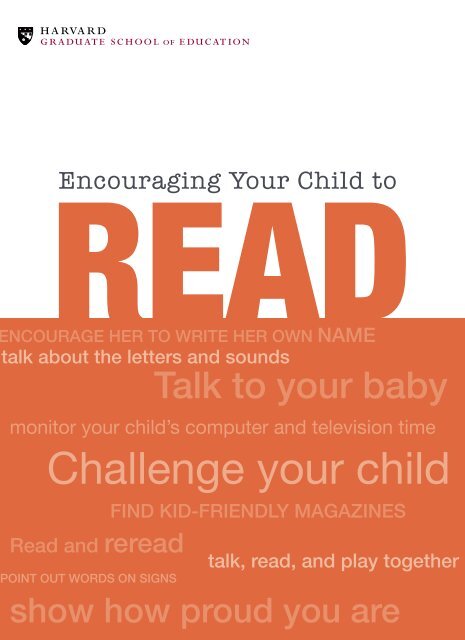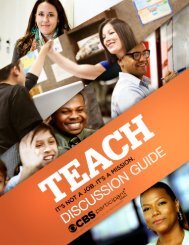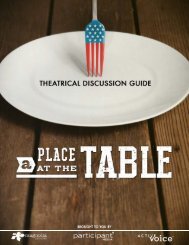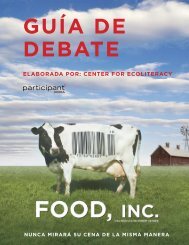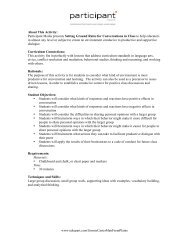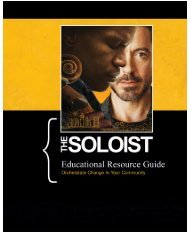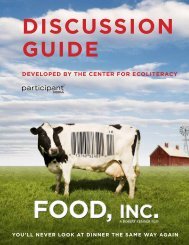Encouraging Your Child to Read - TakePart
Encouraging Your Child to Read - TakePart
Encouraging Your Child to Read - TakePart
- No tags were found...
You also want an ePaper? Increase the reach of your titles
YUMPU automatically turns print PDFs into web optimized ePapers that Google loves.
<strong>Encouraging</strong> <strong>Your</strong> <strong>Child</strong> <strong>to</strong><strong>Read</strong>ncourage her <strong>to</strong> write her own nametalk about the letters and soundsTalk <strong>to</strong> your babymoni<strong>to</strong>r your child’s computer and television timeChallenge your childfind kid-friendly magazines<strong>Read</strong> and rereadtalk, read, and play <strong>to</strong>getherPoint out words on signsshow how proud you are
“ Developinga lifelong loveof reading isa foundationfor successin school andhappinessin life.”The love of reading can and should begin forchildren in their earliest days and continuethroughout their years in school and on in<strong>to</strong> theiradult lives. Becoming a strong and confident readeris a necessary skill, no matter what path a child’slife takes. Literacy is as important <strong>to</strong> a growing childas nutrition, exercise, fresh air, and a loving home.Developing a lifelong love of reading is a foundationfor success in school and happiness in life.The vital importance of literacy is a central underlyingtheme in the film WAITING FOR “SUPERMAN.”Daisy, one of the children in the film, wants <strong>to</strong> bea veterinarian. When asked how she got the idea,Daisy answers, “Because I read books.” That simple,beautiful statement sums up how crucial the ability<strong>to</strong> read — and take pleasure in reading — is foreveryone.This pocket guide, created by faculty membersat the Harvard Graduate School of Education, isbrought <strong>to</strong> you by the producers of WAITING FOR“SUPERMAN” in cooperation with Reach Out and<strong>Read</strong>, which prepares America’s youngest children<strong>to</strong> succeed in school by partnering with doc<strong>to</strong>rs<strong>to</strong> prescribe books and encourage families <strong>to</strong> read<strong>to</strong>gether.We believe this booklet can contribute <strong>to</strong> majorreform, so that all our children can becomesuperheroes — and super readers.Happy reading!<strong>Encouraging</strong> <strong>Your</strong> <strong>Child</strong> <strong>to</strong><strong>Read</strong>table of contents<strong>Your</strong> baby (birth–18 months)...................................... 2<strong>Your</strong> <strong>to</strong>ddler (18 months–3 years).............................. 4<strong>Your</strong> <strong>to</strong>ddler/preschooler (3 years–5 years)................ 6<strong>Your</strong> early elementary student (grades K–2)............... 8<strong>Your</strong> upper elementary student (grades 3–5)............ 10<strong>Your</strong> young teen (grades 6–9).................................. 12Supporting your child’s success.............................. 14Suggested reading.................................................. 161
(birth–18 months)<strong>Your</strong> BabyWhat <strong>to</strong> know:• Babies learn language while being held and cared for byadults who repeat words <strong>to</strong> them; tell them s<strong>to</strong>ries; laughand smile with them; and respond <strong>to</strong> their noises, smiles,and burps.• When you read <strong>to</strong> your baby, she’s learning. Plus, shebegins <strong>to</strong> connect reading with what she loves most —being with you!How <strong>to</strong> help:• Talk <strong>to</strong> your baby! Repeat nursery rhymes, sing songs, playpeek-a-boo, and respond <strong>to</strong> her needs with soothing words.• Take advantage of everyday moments <strong>to</strong> talk about the worldaround you. Tell her s<strong>to</strong>ries while she is being changed, inthe bath, in her stroller, or being held. She needs <strong>to</strong> hear yourvoice and learn about things that she sees.• <strong>Read</strong> board books with faces, animals, and objects that youcan talk about with your baby, then add lift-the-flap bookswhen reading with your 1-year-old.• When talking <strong>to</strong> your child, use the language(s) that are mostcomfortable for you, so that she hears lots of different wordsand ideas.2• Uses her voice <strong>to</strong> express her feelings (laughing, crying)• Imitates speech by saying things like “na-na, da-da”• Understands several simple phrases• At 1 year, can say one or more words• Looks at books3
(18 months–3 years)<strong>Your</strong> ToddlerWhat <strong>to</strong> know:• <strong>Child</strong>ren become “readers” before they learn <strong>to</strong> read. Enjoyingbooks <strong>to</strong>gether now will help them enjoy books later.• When children have lots of opportunities <strong>to</strong> talk and listen,they are building important language skills.How <strong>to</strong> help:• Listen <strong>to</strong> your child talk and encourage her <strong>to</strong> say more. Askher questions, show interest in what she says, and help herlearn new words and ideas.• When you are with your child, limit distractions like phonecalls and television. Instead, talk, read, and play <strong>to</strong>gether.Consider borrowing books from the library.• Make books a part of the daily routine. Special reading timemight be before bed, during a meal, or while you are ridingthe bus.• Give your child paper and crayons so she can “write.” Askher <strong>to</strong> explain what is happening in her picture or s<strong>to</strong>ry. Helpher think of more ideas <strong>to</strong> add.4• At 2 years, can say 250–350 words• At 3 years, can say 800–1000 words• Says common rhymes, imitates the <strong>to</strong>ne and sounds of adultsspeaking, and asks <strong>to</strong> be read <strong>to</strong>• Enjoys listening <strong>to</strong> predictable, familiar books and joins inwhen it is time <strong>to</strong> say a repeated phrase in the s<strong>to</strong>ry5
6<strong>Your</strong> Toddler/Preschooler(3 years–5 years)• Comfortably uses sentences, plays with words, and learnsfrom conversations and books that are read aloud• Recognizes familiar letters and words such as her name —and attempts <strong>to</strong> write them• Identifies words that rhyme or have the samebeginning soundWhat <strong>to</strong> know:• Learning lots of words from birth helps <strong>to</strong> make preschoolersreaders for life.• <strong>Child</strong>ren become “writers” before they learn <strong>to</strong> write. <strong>Child</strong>ren’sscribbles, pictures, and attempts at writing alphabetletters are all important beginnings <strong>to</strong> strong literacy skills.How <strong>to</strong> help:• When reading <strong>to</strong>gether, encourage your child <strong>to</strong> talk. Haveher “pretend read” the parts she has memorized. Ask herquestions and encourage her <strong>to</strong> say more. Eventually, shemight tell more of the s<strong>to</strong>ry than you do!• Point out words on signs and talk about the letters andsounds. Ask your child <strong>to</strong> find letters she knows on menusor street signs.• Link the books you read <strong>to</strong> people, places, and things yourchild knows or sees when you’re out.• Play with words and sounds by singing, reading, and makingup rhymes <strong>to</strong>gether. Call attention <strong>to</strong> words that have similarsounds (“Dad and dance both start with the same sound,d-d-d-d dad, d-d-d-d dance!”)• Have your child tell you s<strong>to</strong>ries, and write down what shesays. Ask questions that will help her complete the s<strong>to</strong>ry.Then, read the s<strong>to</strong>ry you wrote <strong>to</strong>gether.• Holds a book right-side-up, turns the pages, andunderstands that pages are read from left <strong>to</strong> right andfrom <strong>to</strong>p <strong>to</strong> bot<strong>to</strong>m 7
<strong>Your</strong> Upper Elementary Student(grades 3–5)10• At 8 years, reads chapter books and is now learning anestimated 3,000 words per year• At 9 years, can read aloud and silently, and understandwhat is read• At 10 years, begins <strong>to</strong> identify the themes in a textWhat <strong>to</strong> know:• The words we use in conversation are different from thewords we see in books. Students need <strong>to</strong> understand thisacademic language in order <strong>to</strong> succeed in school.• Starting in grade 4, children are expected <strong>to</strong> “read <strong>to</strong>learn” — <strong>to</strong> gain information from books independently.• <strong>Child</strong>ren need encouragement, praise, and patience,especially when they are struggling in school.How <strong>to</strong> help:• Hang maps or other word-filled posters. Hang her schoolwork<strong>to</strong> show how proud you are and emphasize theimportance of working hard at school.• Challenge your child by reading aloud books or s<strong>to</strong>ries fromthe newspaper — electronic or print — that she cannot readon her own and by introducing her <strong>to</strong> new ideas and <strong>to</strong>pics.• Keep what your child enjoys reading around the house.Many children enjoy kid-friendly magazines that you canfind at your library or order by mail.• Talk <strong>to</strong> your child’s teacher. Learn about classroom work andhow you can help at home.11
(grades 6–9)<strong>Your</strong> Young Teen12• Chooses things <strong>to</strong> read that she wants <strong>to</strong> talk and write about• Understands how authors think• Can compare points of view and ideas from different bookson the same <strong>to</strong>pic• Learns new information while reading, <strong>to</strong> develop her ideasand knowledgeWhat <strong>to</strong> know:• Many children lose interest in reading during middle school.Finding reading material every day that captures their interestcan help them continue <strong>to</strong> build knowledge and skills.• Vocabulary growth is critical throughout middle school <strong>to</strong>prepare for understanding high school textbooks.• Many children need extra support as reading requirementsincrease during these years.How <strong>to</strong> help:• Talk with your child about what is in the news, or what ishappening at your workplace or at her school. Like manyteens, she values privacy, but appreciates knowing thatyou are there for her.• Put word games, trivia challenges, or light reading materialsaround the home where she will see them and hopefullypick them up <strong>to</strong> read.• Encourage good study habits, like setting goals, completingassignments on time, and asking for help from a teacherwhen needed. Establish a space at home for homework.• Get your child involved in activities she enjoys such assports, volunteering, music, or book clubs. These activitieshelp her explore interests and keep her connected <strong>to</strong> school.• If your older teen has trouble with comprehension, readit yourself and discuss it with her, then encourage her <strong>to</strong>try again.• Can experience success when reading about subjects thatare familiar and interesting <strong>to</strong> her, even when she struggleswith school reading 13
Supporting <strong>Your</strong> <strong>Child</strong>’sSUCCESS• Visit the library and borrow books for yourselfas well as for your child. Talk <strong>to</strong> your child aboutwhat you are reading. It is key <strong>to</strong> show your childthat you enjoy reading and think that learningis important.• Scatter books, magazines, newspapers, andcomics in everyday places — the car, her bedroom,or the breakfast table.• View websites <strong>to</strong>gether with your child, sharee-books, even listen <strong>to</strong> audiobooks. This allcounts as reading — every little bit helps!• Listen and talk <strong>to</strong> your child. She is never <strong>to</strong>o young orold <strong>to</strong> learn from conversation. Talk about things thatinterest her and encourage her <strong>to</strong> ask questions.• Have conversations with teens about current events andhappenings in your community.• Stay involved throughout yourchild’s years in school. Attendparent-teacher conferences andchaperone field trips. Or arrangeanother time when you can meetwith teachers or talk by phone.Show your child that her educationis important <strong>to</strong> you.• Remember, reading is social.Talking about what kids andadults are reading is part ofacademic success!“Talk <strong>to</strong> your childabout what youare reading. It iskey <strong>to</strong> show yourchild that you enjoyreading and thinkthat learningis important. ” 1514
Suggestedreading<strong>Your</strong> BabyGoodnight MoonBy Margaret Wise BrownMy AnimalsBy Xavier DeneuxPat the BunnyBy Dorothy KunhardtClap HandsBy Helen OxenburyThe Peace BookBy Todd Parr<strong>Your</strong> ToddlerMoo Baa La La LaBy Sandra Boyn<strong>to</strong>nThe Very Hungry CaterpillarBy Eric CarleThe Snowy DayBy Ezra Jack KeatsIs <strong>Your</strong> Mama a Llama?By Deborah Guarino, illustrated bySteven KelloggShades of PeopleBy Shelley Rotner and Sheila M. Kelly,pho<strong>to</strong>s by Shelley Rotner<strong>Your</strong> Early Elementary StudentMy Name is / Mellamo GabrielaBy Monica Brown,illustrated by John ParraThe Girl Who LovedWild HorsesBy Paul GobleWhere the MountainMeets the MoonBy Grace LinNumber the StarsBy Lois LowryBridge <strong>to</strong> TerabithiaBy Katherine Paterson,illustrated by Donna DiamondThe Day of Ahmed’s SecretBy Florence Parry Heideand Judith Heide Gilliland,illustrated by Ted LewinFrog and Toad seriesBy Arnold LobelMartha SpeaksBy Susan Meddaugh<strong>Your</strong> Upper Elementary StudentLittle House seriesBy Laura Ingalls WilderFreedom SummerBy Deborah Wiles, illustratedby Jerome Lagarrigue<strong>Your</strong> Toddler/PreschoolerCorduroyBy Don FreemanHarold and the Purple CrayonBy Crockett Johnson16If You Give a Mouse a CookieBy Laura Joffe Numeroff,illustrated by Felicia BondThe Lion & the MouseBy Jerry PinkneyWhere the Wild Things AreBy Maurice Sendak<strong>Your</strong> Young TeenThe Hunger Games seriesBy Suzanne CollinsThe Ear, the Eye, and theArm: A NovelBy Nancy FarmerThe OutsidersBy S.E. Hin<strong>to</strong>nHolesBy Louis SacharWhen You Reach MeBy Rebecca Stead17
<strong>Encouraging</strong> <strong>Your</strong> <strong>Child</strong> <strong>to</strong> <strong>Read</strong>was conceived by Harvard GraduateSchool of Education facultymembers Joe Blatt, Nonie Lesaux,and Catherine Snow and writtenby Nonie Lesaux with help fromresearch assistants Joan Kelley,Michelle Hastings, and Julie Russ.Spanish translation by ArmidaLizarraga, with the assistance ofEmma Billard, Paola Uccelli, andAndres Galindo.To accompany WAITING FOR“SUPERMAN,” the producersParamount Pictures, ParticipantMedia, and Walden Media areconducting a nationwide socialaction campaign dedicated, in part,<strong>to</strong> promoting children’s literacy.Working in collaboration withour literacy partners First Book ® ,Reach Out and <strong>Read</strong>, City Year,and Jumpstart, we seek <strong>to</strong> ensurethat all parents understand theimportance of reading and haveaccess <strong>to</strong> age-appropriate books fortheir families. To learn more, pleasevisit www.waitingforsuperman.com/action.Production Manager/Edi<strong>to</strong>r:Marin JorgensenAll pho<strong>to</strong>s provided by:Reach Out and <strong>Read</strong>, Inc. and First BookDesign: www.acecreative.bizThis pocket guide is distrib utedin partnership with Reach Outand <strong>Read</strong>, the national non profit,school readiness organization.Tools for Parents: For readingtips and “doc<strong>to</strong>r-recommended”children’s books, visitwww.reachoutandread.org/parents.First Book, a nonprofit organizationthat provides new books<strong>to</strong> children in need, addressesone of the most importantfac<strong>to</strong>rs affecting literacy —access <strong>to</strong> books. Learn moreat www.firstbook.org.City Year unites young peopleof all backgrounds for a year offull-time service, giving them theskills and opportunities <strong>to</strong> changethe world. These diverse youngleaders help turn around high needschools and get students back ontrack <strong>to</strong> graduation. Learn more atwww.cityyear.org.Jumpstart recruits and trainscaring adults <strong>to</strong> work with preschoolchildren in low-incomeneighborhoods, helping them <strong>to</strong>develop the language and literacyskills they need <strong>to</strong> succeed inschool and in life. Learn more atwww.jstart.org.The distribution in English and inSpanish of <strong>Encouraging</strong> <strong>Your</strong> <strong>Child</strong><strong>to</strong> <strong>Read</strong> is made possible by agenerous grant from The AnschutzFoundation.


